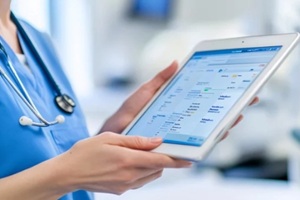 Moving in a digital era, healthcare organizations are now adopting Internet of Things (IoT) solutions to improve patient care, streamline operations, and safeguard sensitive health data. Maintaining data privacy is an essential aspect of modern practices since a substantial portion of healthcare is conducted remotely, through wearable devices, and other network-enabled IoT devices. Data safety issues at any point along the network can endanger patients or lead to legal repercussions.
Moving in a digital era, healthcare organizations are now adopting Internet of Things (IoT) solutions to improve patient care, streamline operations, and safeguard sensitive health data. Maintaining data privacy is an essential aspect of modern practices since a substantial portion of healthcare is conducted remotely, through wearable devices, and other network-enabled IoT devices. Data safety issues at any point along the network can endanger patients or lead to legal repercussions.
This article breaks down regulatory frameworks for modern healthcare practices, including the laws that govern data privacy and strategies. The goal of these strategies is to integrate healthcare IoT devices into modern healthcare practices while keeping customer, employee, and company data safe.
Understanding Healthcare Data Privacy Requirements
Since the healthcare industry has embraced IoT integration, healthcare data privacy has become far more complex over the last decade. With so many devices tracking, transmitting, and storing individualized patient data, state and federal regulations have changed regarding patient data safety.
When integrating healthcare strategies with healthcare IoT devices, practices must understand the core regulatory frameworks that govern their liability. These include HIPAA, international, and state regulations.
HIPAA Compliance
“HIPAA compliance” refers to the Health Insurance Portability and Accountability Act, which establishes the standards for protecting patient information in the United States. Healthcare practices must recognize how HIPAA regulations impact IoT integration by meeting specific standards.
These include perimeter security protocols, which determine how network perimeters are protected from unauthorized intrusion. Classifying and securing each new IoT device is essential for practices to maintain HIPAA compliance.
International Standards
When healthcare practices collect and process data from international patients, their practice becomes subject to international data privacy standards. For example, the General Data Protection Regulation (GDPR) establishes requirements for international practices that treat patients in the European Union (EU).
These requirements include data minimization, which restricts data collection to the intended medical purpose only. Now that so many patients are treated through telemedicine systems, obtaining proper consent for data collection and implementing security features is even more essential .
State Regulations
In addition to federal and international laws, healthcare practices should recognize their state’s local legislation concerning data privacy and healthcare IoT device integration. Each practice must be diligent with how these regulations are acknowledged and implemented when treating patients from their state as well as from across state lines, in which case, other laws may become relevant.
Security Architecture for Healthcare IoT
Robust security is essential to protect an IoT-enabled healthcare network environment. Modern data security works in layers that include overall network security, the security on individual devices, and the practice’s data encryption process. The goal of IoT data privacy is to lower the practice’s risk for unauthorized data access or accidental breaches, which can have far-reaching implications for patient safety and the office’s reputation.
Three essential aspects form the foundation of modern IoT data security:
 Network Security: Foundational network security includes firewalls, network intrusion detection, and segmentation. This helps practices block unauthorized users, authenticate current users, and isolate sensitive data flows for more efficient monitoring.
Network Security: Foundational network security includes firewalls, network intrusion detection, and segmentation. This helps practices block unauthorized users, authenticate current users, and isolate sensitive data flows for more efficient monitoring.- Device Security: In addition to broader network security, each device on an IoT network should be individually secured to prevent potential tampering. To guarantee secure data collection, analysis, and storage, modern practices must maintain regular firmware updates and security processes on each connected device.
- Data Encryption: Data collected by IoT devices is transmitted and stored on the network, which can lead to interception without proper encryption methods. Modern encryption guarantees that unauthorized access will not result in stolen information.
This layered approach to data privacy, from broad to specific network applications, helps healthcare practices maintain full visibility over their data privacy workflows even while adding new IoT devices to the network.
Access Control and Authentication
In addition to securing the data itself, access control and authentication help healthcare practices authorize those with access to sensitive health data.
- User Management and role-based permission systems are essential to enforcing data access policies, including regular audits of account privileges.
- Device Authentication involves frequently checking the IoT devices connected to the network and confirming their status with certificate-based authentication methods.
- Audit Logs include data access and system interaction information that supports potential investigations in the event of a data privacy issue.
Access control is a complex, ongoing process in healthcare IoT network integration. Practices must make sure that only authorized users can access sensitive patient data and that their network has safety measures in place in the event that outdated or unauthorized devices invade the network.
Data Storage and Transmission Protocols
Data storage and transmission processes impact IoT network security. Servers must be HIPAA-compliant, encrypted, and protected against power outages. When transmitting information, practices must maintain secure data protocols like TLS and HTTPS to secure transmissions on both public and private networks.
Incident Response and Recovery Planning
Even well-planned and comprehensive data security measures can fail due to cyberattacks, outdated firmware, or new healthcare IoT devices. If a breach happens, healthcare organizations must establish a clear response workflow that includes identification, containment, elimination, and system restoration.
Additionally, internal teams should be notified of the breach, including a list of the affected patients. The relevant regulatory bodies should be contacted and informed of the current response methods and data recovery strategies.
Protect Your Patient Data Today with Healthcare IoT Solutions
 As IoT devices increase in value and prevalence in healthcare practices, patient data privacy has become a more central issue for both practices and patients. Secure network infrastructures comply with local, federal, and international regulations for encryption, access controls, data storage, and more.
As IoT devices increase in value and prevalence in healthcare practices, patient data privacy has become a more central issue for both practices and patients. Secure network infrastructures comply with local, federal, and international regulations for encryption, access controls, data storage, and more.
Modern practices often struggle to manage these processes alone, which is why wireless providers like the experienced team at Allpoint Wireless partner with healthcare practices to provide reliable security workflows and compliant connectivity monitoring.
At Allpoint, we offer the nation’s #1 low-cost and reliable wireless solutions and provide customizable technical support. Contact our team today to learn how secure and scalable wireless solutions can be customized to the data privacy needs of a modern healthcare environment.